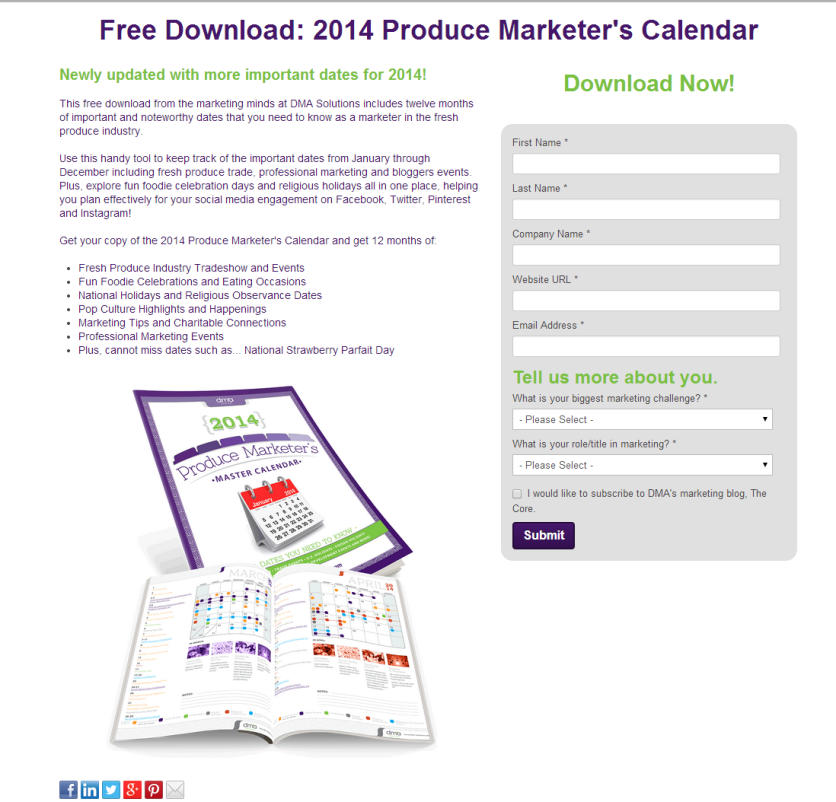 We’ve been writing a lot lately about inbound marketing, tracking website visitors, and creating content that matters to your consumers, all of which work to improve your brand awareness and to build brand ambassadors for your company. A key component to inbound marketing and creating consumer connections are landing pages. These are webpages that educate prospective customers or consumers about the information you are sharing and help them to solve a problem, be inspired by recipes or motivated by a promotion. Here’s an example of a landing page that proved to be very useful for our audience; over 35% of people who landed on this page downloaded the 2014 Produce Calendar.
We’ve been writing a lot lately about inbound marketing, tracking website visitors, and creating content that matters to your consumers, all of which work to improve your brand awareness and to build brand ambassadors for your company. A key component to inbound marketing and creating consumer connections are landing pages. These are webpages that educate prospective customers or consumers about the information you are sharing and help them to solve a problem, be inspired by recipes or motivated by a promotion. Here’s an example of a landing page that proved to be very useful for our audience; over 35% of people who landed on this page downloaded the 2014 Produce Calendar.

Here are some insights we have gleaned the last few years that have helped us create landing pages that convert:
Motivate Action – Motivate visitors to fill out a form by giving them something of value such as free downloads, guides, consultations, reports, samples or other exclusive content – or an “offer.” Your website visitors are looking for information relative to your products to help them solve a problem or fulfill a need. Landing pages with content that matters to consumers produce higher conversion rates.
Ask Questions – Landing pages use forms to capture helpful information about audience preferences. The questions on forms are how we gain insights into the types of content consumers want. Use forms to capture important information about your customer– first name, last name, email, phone number, types of content they like to consume, how they prefer to be communicated with, etc. Ultimately this information will help you learn how to personalize communications for consumers.
Appeal Visually – Create information that is quick and easy to consume. According to Zabisco, 90% of information transmitted to the brain is visual, and visuals are processed 60,000X faster than text. Landing page content should use graphics, strong titles, language that is easily digestible, and visually appealing layouts that immediately convey the value of your offer.
Avoid Distraction – Your landing page needs to keep visitors focused on completing the form and not links that take visitors away from the landing page. This will help you collect be more successful in collecting the valuable information needed to get to know your consumers.
Encourage Sharing – Encourage your visitors to share your offer in efforts to convert other potential brand champions. By including social sharing links on landing pages you make it easy for your visitors to do just that.
Give Thanks – Always remember to give thanks once a user has completed a form on a landing page. Direct them to a thank you page to show gratitude for their interest and to keep them engaged by suggesting additional content that would be of value to them.
Landing pages provide what visitors are looking for in a more simple way and eliminate confusion that occurs when searching through an entire website. Through these landing page best practices, you will be on your way to attracting and delighting consumers while also gathering intel on what your audience wants to know from you. Discover more about landing pages and other insights into inbound marketing by downloading our latest offer: Intro to Inbound Marketing.
‘{{cta(‘3de60b2b-1bb3-4585-b10b-c5a1f259a5f1’)}}











